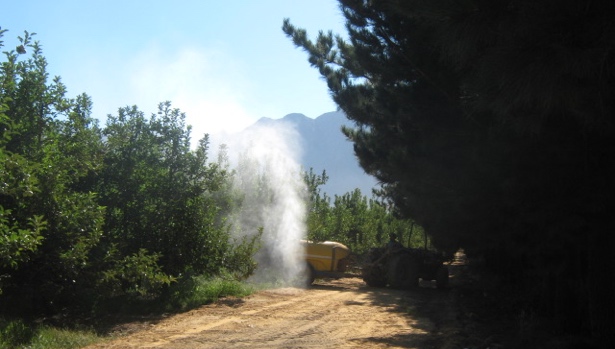In this post, Sebastian Stehle informs about their recent paper “Erosion rills offset the efficacy of vegetated buffer strips to mitigate pesticide exposure in surface waters“.

Pesticide application in orchards in the Lourens River catchment, South Africa (photo by U. Bangert)
Elaborate environmental risk assessment schemes are conducted prior to the authorization of pesticide compounds in order to ensure their environmental safe use. The potential exposure of surface waters is evaluated using exposure models, which predict the pesticide concentrations caused, for example, by rainfall-induced runoff events. Higher-tier exposure modeling often incorporates vegetated buffer strips as risk mitigation option for the prediction of surface water concentrations, with buffer strip width considered as the only factor determining the reduction efficacy (e.g., a 60% and 80% reduction of runoff-related pesticide surface water concentrations are assumed for a buffer width of 10-12 m and 18-20 m, respectively). Importantly, apart from the factor width, further buffer strip characteristics such as vegetation density or the presence of erosion rills (i.e., concentrated flow paths leading directly to the bank of a water body) are generally neglected in the regulatory pesticide exposure assessment.
We conducted in our study a field survey in the Lourens River catchment, South Africa, which specifically focused on the characteristics and attributes of buffer strips separating orchard areas from small streams. The results show that erosion rills are widespread and common in buffer strips of the streams in the investigation area (up to 6.5 erosion rills per km flow length). Surface water samples taken up- and downstream of erosion rills prove that erosion rills represent concentrated entry pathways of pesticide runoff into the streams during rainfall events. In addition, we applied two different approaches of GIS-based runoff modeling differing in their consideration of erosion rills. As a result, measured pesticide surface water concentrations correlated significantly with runoff losses predicted by the modeling approach in which buffer strip width was set to zero at sites with erosion rills; in contrast, no relationship between predicted runoff losses and in-stream pesticide concentrations were detected in the modeling approach that neglected erosion rills and thus assumed efficient buffer strips. These runoff modeling results suggest that the retention capacity of a vegetated buffer strip containing erosion rills is equal to a buffer width of 0 m, i.e., the non-existence of this buffer strip.
Overall, the results of our study show that erosion rills may completely offset the efficacy of vegetated buffer strips to mitigate pesticide surface water exposure. Our findings thus strongly suggest that the capability of buffer strips as a risk mitigation tool for runoff is largely overestimated in the current regulatory pesticide exposure assessment procedures conducted for pesticide authorization. We therefore advocate that the field-relevance, effectiveness and protectiveness of buffer strip-related mitigation options employed in the prospective regulatory risk assessment schemes should be thoroughly reconsidered in order to reduce adverse environmental side-effects arising from current and future agricultural pesticide use.
The article “Erosion rills offset the efficacy of vegetated buffer strips to mitigate pesticide exposure in surface waters“ was authored by Sebastian Stehle, James M. Dabrowski, Uli Bangert, and Ralf Schulz and published in Science of the Total Environment.
